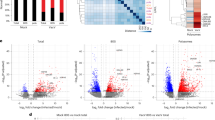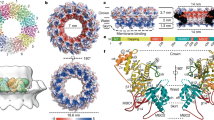Abstract
PICORNAVIRUSES infecting susceptible animal cells inhibit synthesis of host proteins and direct the cells to synthesise viral proteins1. The mechanism for the shut-off of host cell protein synthesis is not understood, although several experiments indicate that initiation of host protein synthesis is specifically inhibited1. When initiation of protein synthesis is reduced by exposing cells infected by picornaviruses to hypertonic medium, synthesis of viral proteins is greatly favoured over that of host proteins2,3. This suggests that viral templates are more successful in initiation than host templates3. Competition between picornavirus RNA and host mRNAs has been shown directly by in vitro translation experiments4,5. When these RNAs are added together in saturating amounts to a cell-free protein-synthesising system, viral RNA is preferentially translated over host mRNA4,5. This competition can be relieved by addition of initiation factor eIF-4B (previously designated IF-M3)6. This has suggested that eIF-4B may be present in limiting amounts in the translation assays, and that viral and host templates compete for available factor6. This observation is somewhat surprising, as the 5′-terminal cap sequence m7G5′pppXmp... is involved in the binding of mRNA to eIF-4B, and picornavirus RNA is not capped (see refs 7 and 8). It has been found that other nucleotide sequences outside the cap participate in this reaction9, but the presence of 5′-terminal m7G in mRNA promotes interaction with eIF-4B and the initiation process7,8. Therefore, templates with a ‘capped’ 5′-terminal nucleotide bind to ribosomes more rapidly than their unmethylated counterparts10,11. We have shown previously that eIF-4B interacts with the RNA of encephalomyocarditis (EMC) virus, a picornavirus, in a nitrocellulose filter binding assay7. It has also been shown that eIF-4B is required for in vitro translation of EMC virus RNA12. In the present report we have examined the basis for the competition between EMC virus RNA and a cellular mRNA at the molecular level. EMC virus RNA binds to ribosomes at a rate similar to that of capped mRNAs, suggesting that features other than the 5′-terminal m7G are responsible for the binding of this viral RNA. By measuring the relative affinity of globin mRNA and EMC virus RNA for eIF-4B, we have found that the viral RNA has a greater affinity for this initiation factor than globin mRNA. This high affinity for eIF-4B could explain the fast rate of initiation of the viral RNA and the shut-off of host cell protein synthesis after picornavirus infection.
This is a preview of subscription content, access via your institution
Access options
Subscribe to this journal
Receive 51 print issues and online access
$199.00 per year
only $3.90 per issue
Buy this article
- Purchase on SpringerLink
- Instant access to full article PDF
Prices may be subject to local taxes which are calculated during checkout
Similar content being viewed by others
References
Baltimore, D. in Biochemistry of Viruses (ed. Levy, H. B.) 101–176 (Marcel Dekker, New York, 1969).
Saborio, J. L., Pong, S. S. & Koch, G. J. molec. Biol. 85, 195–211 (1974).
Nuss, D. L., Opperman, H. & Koch, G. Proc. natn. Acad. Sci. U.S.A. 12, 1258–1262 (1975).
Lawrence, C. & Thach, R. E. J. Virol. 14, 598–610 (1974).
Abreu, S. & Lucas-Lenard, J. J. Virol. 18, 182–194 (1976).
Golini, F. et al. Proc. natn. Acad. Sci. U.S.A. 73, 3040–3044 (1976).
Shafritz, D. et al. Nature 261, 291–294 (1976).
Shatkin, A. J. Cell 9, 645–653 (1976).
Padilla, M. et al. J. biol. Chem. (in the press).
Rose, J. K. & Lodish, H. F. Nature 262, 32–37 (1976).
Weber, L. A., Hickey, E. D., Nuss, D. L. & Baglioni, C. Proc. natn. Acad. Sci. U.S.A. 74, 3254–3258 (1977).
Staehelin, T. Trachsel, H., Erni, B., Boschetti, A. & Schreier, M. H. Proc. 10th FEBS Meeting 1975, 309–323 (Elsevier' Amsterdam, 1975).
Weber, L. A., Hickey, E. D., Maroney, P. A. & Baglioni, C. J. biol. Chem. 252, 4007–4010 (1977).
Baltimore, D. & Huang, A. S. J. molec. Biol. 47, 263–273 (1970).
Moss, B., Gershowitz, A., Weber, L. A. & Baglioni, C. Cell 10, 113–120 (1977).
Brooker, J. & Marcus, A. FEBS Letts. 83, 118–124 (1977).
Doyle, S. & Holland, J. J. Virol. 9, 22–28 (1972).
Ehrenfeld, E. & Lund, H. Virology 80, 297–308 (1977).
Lee, Y. F., Nomoto, A. & Wimmer, E. Proc. natn. Acad. Sci. U.S.A. 74, 5963 (1977).
Flanegan, J. B., Petterson, R. F., Ambros, V., Hewlett, M. J. & Baltimore, D. Proc. natn. Acad. Sci. U.S.A. 74, 961–965 (1977).
Nomoto, A., Lee, Y. F. & Wimmer, E. Proc. natn. Acad. Sci. U.S.A. 73, 375–380 (1976).
Hewlett, M. J., Rose, J. K. & Baltimore, D. Proc. natn. Acad. Sci. U.S.A. 73, 327–330 (1976).
Fernandez-Munoz, R. & Darnell, J. E. J. Virol. 18, 719–726 (1976).
Freienstein, C. & Blobel, G. Proc. natn. Acad. Sci. U.S.A. 72, 3392–3396 (1975).
Wigle, D. T. & Smith, H. E. Nature new Biol. 242, 136–140 (1973).
Tereba, A. & McCarthy, B. J. Biochemistry 12, 4675–4678 (1973).
Commerford, S. L. Biochemistry 10, 1993–1999 (1971).
Fernandez-Munoz, R. & Lavi, U. J. Virol. 21, 820–824 (1977).
Segal, I. H. in Enzyme Kinetics: Behaviour and Analysis of Rapid Equilibrium and Steady State Enzyme Systems 46–47 (Wiley, New York, 1975).
Pemberton, R. E., Housman, D., Lodish, H. F. & Baglioni, C. Nature new Biol. 235, 99–102 (1972).
Author information
Authors and Affiliations
Rights and permissions
About this article
Cite this article
BAGLIONI, C., SIMILI, M. & SHAFRITZ, D. Initiation activity of EMC virus RNA, binding to initiation factor eIF-4B and shut-off of host cell protein synthesis. Nature 275, 240–243 (1978). https://doi.org/10.1038/275240a0
Received:
Accepted:
Issue date:
DOI: https://doi.org/10.1038/275240a0



